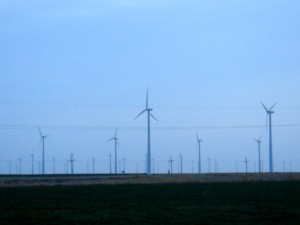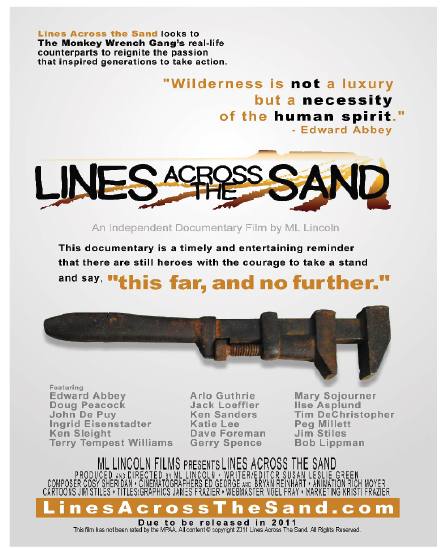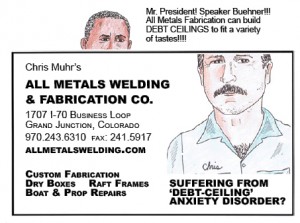TILTING AT WINDMILLS
By Dean Wooten
 There they are. Dark harbingers of the future
There they are. Dark harbingers of the future
Spread across the ridge from horizon to horizon
Slowly turning long arms, malevolent as giant spiders,
Creeping toward eternity.
They call wind turbines green and have won the energy wars without fighting a battle. It proves the power of words. In this case, only one: Green. But what’s green about them? Lined up like imposing fences, whooshing and thumping, they are an almighty obstacle to animal movement. The quietly nodding oil pumps near Pinedale, Wyoming, are justly targeted for interfering with the migration of pronghorn and other animals, yet those oil rigs are relatively benign compared to the intimidating size, sprawl, movement, and noise of wind turbines, and why would BLM, state, and other land managers be more attentive to the placement of wind turbines than they are to oil wells?
And they are deadly. Going about their avian business, birds see space between the blades and think the sky is open. Even if they see the chopping blade descend, air falls out from under them as the blades suck them in to a fatal collision. Of course, birds routinely fly into stationary power lines and other objects, but wind turbines don’t replace these; they and their power lines are an addition to the hazards we’ve already built for birds.
Just as important, wind turbines suck the life out of our land and the people who live on it and pass through it. Since the 1970s, I’ve regularly driven across the vast interior of our country. I still love those driving trips, seeing the land. The land was not pristine even back in the seventies, but it was still rural. For mile after mile, there were only fences and open plains; mountains soared unobstructed in the distance. Occasionally, if I squinted, I could see a ranch house lost in the immensity of the land or a road slicing through to serve a distant community. Now, even in these early years of wind development, it’s hard to travel across the interior without coming across wind farms littering the land for miles. Imagine the land in ten or fifteen years. Many decry the sprawl of cities into formerly rural lands and the creation of mini-ranches that break up the vastness of the plains, contribute to sprawl, and interfere with the movement of animals, yet how much more impact will this widespread, disruptive “green” industry impact our landscape and the wildlife it supports?
Driving west they appear, rank upon rank, endless legions.
Mile after mile they crowd, overpower, the land.
At last this regiment deserts the rearview mirror
But another emerges from the horizon, more hundreds.
A car pulls over. Travelers point and gawk.
The spinning towers, elegant, slowly lift their arms
To help satisfy our greed for power. Yet we forget
How elegant the smokestacks of Pittsburgh once looked.
No matter how many wind farms are built, they can never give us what we need: reliable, anytime energy; they’re only supplemental. Wind turbines, and their cousins, solar panels, are only part-time sources, and they exact a steep price from our environment, given the minor upgrade they provide.
When the wind doesn’t blow, the arms rest,
But the evil is rampant upon our land, and the damage is forever.
We destroy our land to save the world, to salve our guilt,
But the land and our souls pay a lasting price for this answer.
We need our landscape to feed our souls, our minds, our eyes, to preserve our American character. The West once provided that, and mostly still does, but that time is ending. We’ve turned our back on the land as though it no longer matters, zealously forgiving the damage caused by wind and solar power to satisfy our unrepentant lust for energy.
These not-at-all green power sources aren’t the answer; like hydroelectric power, they’re another plague that will turn to bite us in the pants. The answer to climate change lies within ourselves, in purging ourselves of the excesses of energy consumption, in learning that bigger isn’t better and that we already have more energy than we need. That doesn’t mean doing without or downsizing our quest for a higher standard of living. It means establishing new paradigms for that standard of living—replacing wasteful, unnecessary SUVs and pickups with luxurious, appealing, and energy-efficient small cars; promoting well-appointed small homes instead of sprawling, inefficient middle-class mansions. There are answers to climate change; the problem is, we’re pursuing the wrong ones.
DEAN WOOTEN lives in Santa fe, New Mexico
To view this article as a PDF, click here: aug11-32-33
Don’t forget the Zephyr Ads! All links are hot!






The bird whacking problem has concerned me for 15 years. It’s very similar to hydro power killing fish runs. Free power hundreds of miles from where it’s used. Centralized power systems are a failure. The answer is localized power and efficient buildings. It’s mostly as simple as opening your windows at night and closing them during the day.
For the Naysayers…
Read the article below and be informed as to the very real negative effects of Wind Farms, how they are completely ineffective as an energy solution, how they destroy the environment.. are that they are no one’s last hope just more GREEN Folly.
http://www.aweo.org/problemwithwind.html
Nice imagery Dean. I think they are horribly ugly as well but aesthetics are not the biggest issues here..
There are some good things in this article. We should have critics, who look for problems, and who nay say and force things to be scrutinized, before we jump on any bandwangon, including that of the technocratic “green” cottage industries that supposedly will save our world.
That being said, this article is only that. It is a criticism of some effects of wind power. Namely, bird killing and beauty of the land spoiling. Here are a few of my responses.
1) The pictures of a dead Iraqi child, an American veteran with a TBI in a wheelchair for the rest of her life, the white phosphorous of Falluja, and the image in my head of the end result of fossil fueled climate change are A LOT nastier than the windmills on the great plains. If we do not get away from non-renewable, polluting sources of energy, we are going to have a lot nastier future, and it is going to be something that looks a lot more sickening than dead birds knocked out of the air by wind turbines.
2) Small cars… running on what? Diesel (still a limited polluting fuel). Bio-Disel? (Still a polluting fuel) Gasoline? (etc…)
3) Small houses? Build with diesel trucks and workers comm uniting to work in cars?
Let’s say I wave my magic wand of wonderful reforms tomorrow and I encourage us, through family planning to produce less offspring, and through conscious choice we decide to cut the human population in half by using birth control over the next 100 years. Then let’s say through conservation and building smarter and retrofitting I reduce our per capita use of energy by 65%.
Those are tremendous figures no politician of any political party on the planet has any plan of how to achieve.
But let’s just say, we could do it.
Then…. we are still going to need a tremendous amount of energy to power our society.
Solar, Wind, and possibly using solar and wind electricity to split hydrogen from water to make fuel cells to have a portable, on demand energy source, is ultimately what will happen if people are still around after we run out of natural gas, oil, coal and uranium.